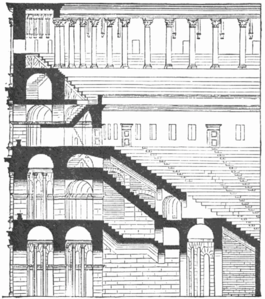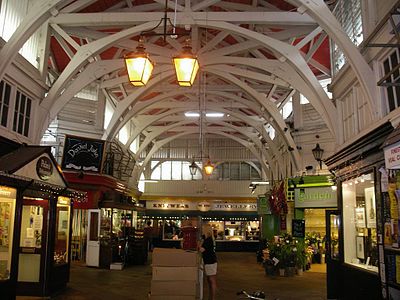Arcade (architecture)
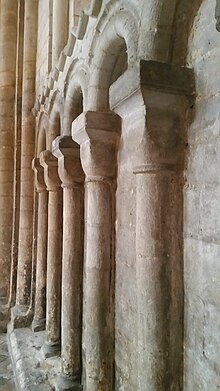
An arcade is a succession of contiguous arches, with each arch supported by a colonnade of columns or piers. Exterior arcades are designed to provide a sheltered walkway for pedestrians; they include many loggias, but here arches are not an essential element. An arcade may feature arches on both sides of the walkway. Alternatively, a blind arcade superimposes arcading against a solid wall.[1]
Blind arcades are a feature of
A different, related meaning is "a covered passage with shops on one or both sides".
The word "arcade" comes from French arcade from Provençal arcada or Italian arcata, based on Latin arcus, ‘bow’ (see arc and arch).[4]
A related but ambiguous term is arcature, which is either a small arcade or a blind arcade.[5][6]
History
Arcades go back to at least the
-
Arcades of the Colosseum (AD 70s) from the outside
-
...and in cross-section
-
These arcades in Córdoba were begun in the 780s; Some are topped by beams, others by barrel vaults.
-
Interiorelevation of a Gothic cathedral, with the side-aisle arcade highlighted. The triforium and clerestoryabove also have arcades.
-
The women's cloister at the Ospedale degli Innocenti, 1420s and 30s. The topmost story has a colonnade, but not an arcade, as there are no arches
Shopping arcades
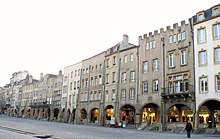
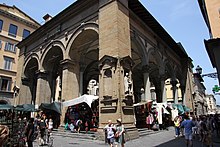
The French architect, Bertrand Lemoine, described the period, 1786 to 1935, as l’Ère des passages couverts (the Arcade Era).[7] He was referring to the grand shopping "arcades" that flourished across Europe during that period. A shopping arcade refers to a multiple-vendor space, operating under a covered roof. Typically, the roof was constructed of glass to allow for natural light and to reduce the need for candles or electric lighting.[8] The 18th and 19th century arcades were designed to attract the genteel middle classes. In time, these arcades came to be the place to shop and to be seen. Arcades offered shoppers the promise of an enclosed space away from the chaos that characterised the noisy, dirty streets; a warm, dry space away from the harsh elements, and a safe haven where people could socialise and spend their leisure time. As thousands of glass covered arcades spread across Europe, they became grander and more ornately decorated. By the mid-nineteenth century, they had become prominent centres of fashion and social life. Promenading in these arcades became a popular nineteenth-century pastime for the emerging middle classes.[9]
The inspiration for the grand shopping arcades may have derived from the fashionable open
Arcades soon spread across Europe, North America and the antipodes. Examples of these grand shopping arcades include:
The Palais-Royal, which opened in 1784 and became one of the most important marketplaces in Paris, is generally regarded as the earliest example of the grand shopping arcades.[13] Originally, a royal palace, the complex consisted of gardens, shops and entertainment venues situated under the original colonnades. The area boasted some 145 boutiques, cafés, salons, hair salons, bookshops, museums, and numerous refreshment kiosks as well as two theatres. The retail outlets specialised in luxury goods such as fine jewellery, furs, paintings and furniture designed to appeal to the wealthy elite. Retailers operating out of the Palais complex were among the first in Europe to abandon the system of bartering, and adopt fixed-prices thereby sparing their clientele the hassle of bartering. Stores were fitted with long glass exterior windows which allowed the emerging middle-classes to window shop and indulge in fantasies, even when they may not have been able to afford the high retail prices. Thus, the Palais-Royal became one of the first examples of a new style of shopping arcade, frequented by both the aristocracy and the middle classes. It developed a reputation as being a site of sophisticated conversation, revolving around the salons, cafés, and bookshops, but also became a place frequented by off-duty soldiers and was a favourite haunt of prostitutes, many of whom rented apartments in the building.[14]
One of the earliest British examples of a shopping arcade, the Covered Market, Oxford, England was officially opened on 1 November 1774 and is still active today. The Covered Market was started in response to a general wish to clear "untidy, messy and unsavoury stalls" from the main streets of central Oxford. John Gwynn, the architect of Magdalen Bridge, drew up the plans and designed the High Street front with its four entrances. In 1772, the newly formed Market committee, half of whose members came from the town and half from the university, accepted an estimate of nine hundred and sixteen pounds ten shillings, for the building of twenty butchers' shops. Twenty more soon followed, and after 1773 meat was allowed to be sold only inside the market. From this nucleus the market grew, with stalls for garden produce, pig meat, dairy products and fish.[citation needed]
Throughout the following century, Gostiny Dvor was augmented, resulting in ten indoor streets and as many as 178 shops by the 20th century. During the post-World War II reconstructions, its inner walls were demolished and a huge shopping mall came into being. This massive 18th-century structure got a face-lift recently and entered the 21st century as one of the most fashionable shopping centres in Eastern Europe.[15]
An early French arcade is the Passage du Caire created in 1798 as a tribute to the French campaign in Egypt and Syria. It was appreciated by the public for its protection from the weather, noise and filth of the streets.[16] A year later American architect William Thayer created the Passage des Panoramas with a row of shops passing between two panorama paintings. Shopping arcades increasingly were built in the second Bourbon Restoration.[17] Upper levels of arcades often contained apartments[18] and sometimes brothels.[19]
-
Inside the Covered Market,roof trussesimitate the form of a stone arcade.
-
Royal Arcade inMelbourne, Victoria, Australia, opened 1870
-
TheCleveland, Ohio, United States, built 1890
-
The Passage des Panoramas, Paris, France
-
The Párizsi udvar in Budapest
-
An orientalist painting of a bazaar arcade in Istanbul in 1840, showing longitudinal and traverse arcades
Notable arcades
Religious buildings
- Great Mosque of Córdoba, Spain
- Mission San Fernando Rey de España - Architecture of the California missions, United States
- Mosque of Uqba, Kairouan, Tunisia
- Real Monasterio de Nuestra Senora de Rueda, AragonAutonomous Community, Spain
- Sanctuary of the Madonna di San Luca, Bologna, Italy
Shopping "arcades"
- Adelaide Arcade, Adelaide, Australia
- Arcade Building, Asheville, North Carolina, United States
- Barton Arcade, Manchester, England
- Block Arcade, Melbourne, Australia
- Brisbane Arcade, Brisbane, Australia
- Burlington Arcade, London, England
- Camayo Arcade, Winchester, Ashland, Kentucky, United States
- Cathedral Arcade, Melbourne, Australia
- City Market, Charleston, South Carolina, United States
- Çiçek Pasajı, Istanbul, Turkey
- Cleveland, Ohio, United States
- The Corridor, Bath, England
- Covered Market, Oxford, England
- Dayton Arcade, Dayton, Ohio, United States
- Eaton Centre, Toronto, Ontario, Canada
- Monticello Arcade, Norfolk, Virginia
- Galerías Pacífico, Buenos Aires, Argentina
- Galeries Royales Saint-Hubert in Brussels, Belgium
- Galleria Vittorio Emanuele II, Milan, Italy
- GPO Arcade, Dublin, Ireland
- Grand Arcade, Leeds, United Kingdom
- Grand Arcade, Wigan, United Kingdom
- Great Western Arcade, Birmingham, England
- GUM, Moscow, Russia
- Galleria Umberto I, Naples, Italy
- Mädler Arcade Gallery, Leipzig, Germany
- Market Arcade, Buffalo, New York, United States[20][21]
- Monticello Arcade, Norfolk, Virginia, United States
- Nashville Arcade, Nashville, Tennessee, United States
- Odesa Passage, Odesa, Ukraine
- Old Bank Arcade, Wellington, New Zealand
- Paddock Arcade, Watertown, New York, United States
- Palais-Royal, Paris, France
- The Passage des Panoramas, Paris, France
- The Passage de l'Argue, Lyon, France
- Piccadilly Arcade London, England
- Queens Arcade, Cardiff, Wales, United Kingdom
- The Royal Arcade, London
- Royal Arcade, Melbourne, Australia
- Rue de Rivoli, Paris, France
- Stanford University, Stanford, California, United States
- Silver Arcade Silver Arcade, Leicester, United Kingdom
- The Strand Arcade and Queen Victoria Building, Sydney New South Wales, Australia
- St. Petersburg, Russia
- St. Petersburg, Russia
- Victoria Quarter, Leeds, England
- Providence, Rhode Island, United States
Gallery
-
Arcade of Sanctuary of the Madonna di San Luca, Bologna, Italy. 2016
-
Arcades inside the Bonne-Espérance Abbey.
-
Courtyard of theGreat Mosque of Damascus
See also
- Alley
- Aqueduct
- Bazaar
- Cloister
- Lanes and arcades of Melbourne, Australia
- List of shopping arcades in Cardiff, Wales, United Kingdom
- List of shopping centres in the United Kingdom
- Loggia
- Marketplace
- Penny arcade
- Retail
- Roman aqueduct
- Shophouse
- Shopping arcade
- Souq
- Stoa
- Tong lau
References
- ^ James Bettley and Nikolaus Pevsner (2007), Essex. The buildings of England, Yale University Press, page 865
- ^ William Chambers (1973), Chambers's encyclopaedia, Volume 1, International Learning Systems Corp, p. 534
- ^
- John Fleming, Hugh Honour and Nikolaus Pevsner, The Penguin Dictionary of Architecture, p. 16, 3rd edn, 1980, Penguin, ISBN 0140510133
- ^ New Oxford American Dictionary
- ^ "arcature". Merriam-Webster.com Dictionary. "1. a small arcade (as in a balustrade). 2. a blind arcade, especially one that is decorative rather than structural."
- ^ Lockwood, Luke Vincent (1913). The Furniture Collectors' Glossary. Walpole Society.
ARCATURE . — A small arcade formed by a series of little arches. It may be blind or open.
- ISBN 9782905118219.
- ^ Mitchell, I., Tradition and Innovation in English Retailing, 1700 to 1850, Routledge, Oxon, p. 140
- ^ Byrne-Paquet, L., The Urge to Splurge: A Social History of Shopping, ECW Press, Toronto, Canada, pp. 92–95
- ^ Pevsner, N., A History of Building Types, Princeton University Press, 1979, p. 235; Goy, R.J., Florence: A Walking Guide to Its Architecture, Yale University Press, 2015; Codini, E.K. (ed), Architettura a Pisa nel Primo Periodo Mediceo, Gangemi, 2003, p.213
- ^ Sassatelli, R., Consumer Culture: History, Theory and Politics, Sage, 2007, p. 27; Although the author specifically names Piccadilly Arcade, it is possible that she intended Burlington Arcade in Piccadilly.
- ^ "Part 1: 1880-1913". arcade. 2019-02-22. Retrieved 2020-04-26.
- ^ Mitchell, I., Tradition and Innovation in English Retailing, 1700 to 1850, Routledge, Oxon, p. 140
- ^ Byrne-Paquet, L., The Urge to Splurge: A Social History of Shopping, ECW Press, Toronto, Canada, pp. 90–93
- ^ Bogdanov, I.A. , Bolshoi Gostiny dvor v Peterburge. SPb, 2001
- ^ p. 174 Desmons, Gilles Walking Paris New Holland Publishers, 2008
- ^ p. 386 Ayers, Andrew The Architecture of Paris: An Architectural Guide Edition Axel Menges, 2004
- ^ p. 32 Benjamin, Walter & Tiedemann, Rolf The Arcades Project Harvard University Press, 1999
- ^ p. 88 Rabaté, Jean-Michel Given: 10 Art 20 Crime : Modernity, Murder and Mass Culture Sussex Academic Press, 2007
- ^ "Market Arcade". Visit Buffalo Niagara. Retrieved 2022-05-30.
- ^ Sommer, Mark (18 February 2017). "European-like Market Arcade is a 'show stopper'". Buffalo News. Retrieved 2022-05-30.


